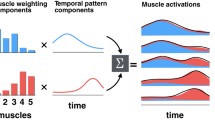Abstract
A technique for calculating the ensemble averages of locomotor electromyographic patterns is decribed. It combines standard linear envelope detection with LaGrange interpolation. The e.m.g. envelope in each stride is demarcated with times obtained from foot-contact patterns and the time base is altered to 256 points by interpolation. The time-normalised envelopes are then averaged together to form the ensemble average.
Similar content being viewed by others
References
Calvert, T. W. andChapman, A. E. (1977) The relationship between the surface e.m.g. and force transients in muscle: simulation and experimental studies.Proc. IEEE,65., 682–689.
Coggshall, J. andBekey, G. (1970) EMG—force dynamics in human skeletal muscle.Med. & Biol. Eng.,8, 265–270.
Crosby, P. (1978) Use of surface electromyogram as a measure of dynamic force in human limb muscles.Med. & Biol. Eng. & Comput.,16, 519–524.
Davenport andRoot (1958)An introduction to the theory of random signals and noise. McGraw-Hill Book Co., Inc., New York.
Dubo, H., Peat, M., Winter, D., Quanbury, A., Hobson, D., Steinke, T. andReimer, G. (1976) Electromyographic temporal analysis of gait: normal human locomotion.Arch. Phys. Med. Rehabil.,57, 415–420.
Eberhart, H. D., Inman, V. T., andBresler, B. (1954) The principle elements in human locomotion. InHuman limbs and their substitutes,Klopsteg,P. E. et al. (Eds.), McGraw-Hill Book Co., New York.
Gottlieb, G. andAgarwal, G. (1970) Filtering electromyographic signals.Am. J. Phys. Med.,49, 142–146.
Grieve, D. W. andCavanagh, P. R. (1974) The validity of quantitative statements about surface electromyograms recorded during locomotion.Scand. J. Rehab. Med. Suppl.,3, 19–25.
Griffin, P., Wheelhouse, W., Shiavi, R. andBass, W. (1977) Habitual toe-walkers, a clinical and electromyographic gait analysis.J. Bone Joint Surg.,59A, 97–101.
Heckathorne, C. andChildress, D. (1981) Relationships of the surface electromyogram to the force, length, velocity, and contraction rate of the cineplastic human biceps.Am. J. Phys. Med.,60, 1–19.
Hershler, C. andMilner, M. (1978) An optimality criterion for processing electromyographic (e.m.g.) signals relating to human locomotion.IEEE Trans.,BME25, 413–420.
Hogan, N. andMann, R. W. (1980) Myoelectric signal processing: optimal estimation applied to electromyograph—Part II: experimental demonstration of optimal myoprocessor performance.,BME27, 396–410.
Jacobs, M., Storecki, J. andCharnley, J. (1972) Analysis of the vertical component of force in normal and pathological gait.J. Biomech.,5, 11–34.
Kadefors, R. (1973) Myo-electric signal processing as an estimation problem. InNew developments in electromyography and clinical neurophysiology,Desmedt,J. E. (Ed.), Karger, Basel.
Knutsson, E. andRichards, C. (1979) Different types of disturbed motor control in gait of hemipharetic patients.Brain,102 (2), 405–430.
Kwatny, E., Thomas, D. andKwatny, H. (1970) An application of signal processing techniques to the study of myoelectric signals.IEEE Trans.,BME17, 303–312.
Parker, P. A., Stuller, J. A. andScott, R. N. (1977) Signal processing for the multistate myoelectric channel.Proc. IEEE,65, 662–674.
Perry, J., Hoffer, M., Antonelli, D., Plut, J., Lewis, G. andGreenberg, R. (1976) Electromyography before and after surgery for hip deformity in children with cerebral palsy.J. Bone Joint Surg.,58A, 201–208.
Pezzack, J. C., Norman, R. W. andWinter, D. A. (1977) An assessment of derivative determining techniques used for motion analysis.J. Biomech.,10, 377–382.
Schafer, R. andRabiner, L. (1973) A digital signal processing approach to interpolation.Proc. IEEE.,61, 692–702.
Shiavi, R., Champion, S., Freemon, F. andGriffin, P. (1981) Variability of electromyographic patterns for levelsurface walking through a range of self-selected speeds.Bull. Proc. Res.,18 (1), 5–14.
Shwedyk, E., Balasubramanian, R. andScott, R. N. (1977) A nonstationary model for the electromyogram.IEEE Trans.,BME24, 217–424.
Simon, S., Deutsch, S., Nuzzo, R., Mansour, M., Jackson, J., Koskinen, M. andRosenthal, R. (1978) Genu recurvatum in spastic cerebral palsy.J. Bone Joint Surg.,60A, 882–894.
Smidt, G., Deusinger, R., Arora, J. andAlbright, J. (1977) An automated accelerometry system for gait analysis.J. Biomech.,10, 367–375.
Thomas, J. (1969)An introduction to statistical communication theory, John Wiley & Sons, Inc., New York.
Winter, D., Rau, G., Kadefors, R., Broman, H. andDeluca, C. (1980) Units, terms and standards in the reporting of e.m.g. research. Report ofad hoc committee of the International Society of Electrophysiological Kinesiology.
Zipp, B. (1978) Effect of electrode parameters on the bandwidth of the surface e.m.g. power-density spectrum.Med. & Biol. Eng. & Comput.,16, 537–541.
Author information
Authors and Affiliations
Rights and permissions
About this article
Cite this article
Shiavi, R., Green, N. Ensemble averaging of locomotor electromyographic patterns using interpolation. Med. Biol. Eng. Comput. 21, 573–578 (1983). https://doi.org/10.1007/BF02442382
Received:
Accepted:
Issue Date:
DOI: https://doi.org/10.1007/BF02442382




